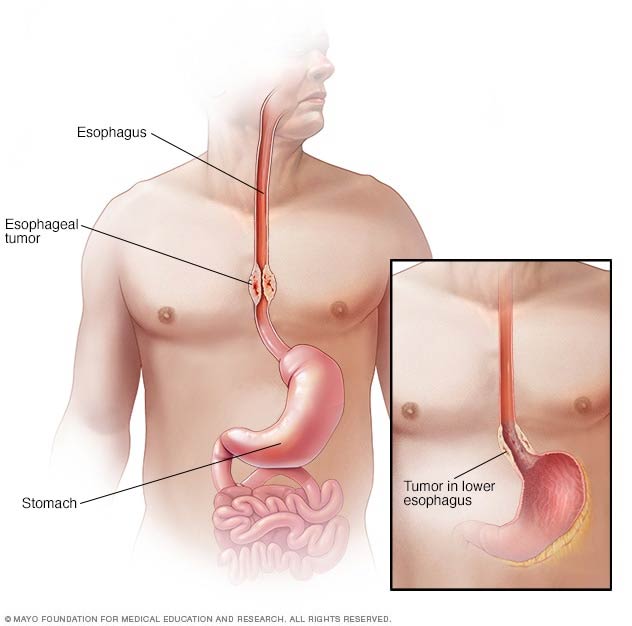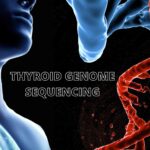Esophageal cancer forms in the esophagus – a hollow, muscular tube about 10 inches long that carries food and drink from the mouth to the stomach.
Esophageal cancer occurs when cells begin to grow and divide abnormally, resulting in a tumor. Tumors typically start in the innermost layer of the esophagus. They can eventually metastasize (spread) to the lymph nodes and other organs.
Even though esophageal cancer is considered rare, compared to cancers of the lungs, breasts, and prostates, the number of people with one of the major types, adenocarcinomas, has risen dramatically in recent decades.
Diagnosis and stage of your disease can be determined from a physical examination and imaging tests such as a CT scan, PET scan, and endoscopy.
You may be treated with surgery, chemotherapy, radiation therapy, or a combination of these methods. Endoscopic therapy is also available today for precancerous conditions and very early-stage cancer. You will have a variety of treatment options based on how far advanced or localized your disease is.

- Esophageal Cancer Symptoms
- Prevention and Risk Factors for Esophageal Cancer
- Types of Esophageal Cancer
- Screening for Esophageal Cancer
- Esophageal Cancer Diagnosis and Stages
- Treatment for Esophalgeal Cancer
- Surgery for Esophageal Cancer
- Chemotherapy for Esophageal Cancer
- Radiation Therapy for Esophageal Cancer
Most people with Esophageal cancer are diagnosed after they notice symptoms. However, early-stage cancers usually do not have warning signs. Some of the most common symptoms include:
- difficulty swallowing (as the tumor grows, the esophagus narrows)
- chest pain or discomfort, such as pressure or a burning sensation
- weight loss and lack of appetite (often related to difficulty swallowing)
- hoarseness
- a persistent cough
- hiccups
- pneumonia
- bone pain
- bleeding in the esophagus
Several of these symptoms are also associated with other medical conditions, so you are not necessarily suffering from esophageal cancer if you experience any of them. Consult your doctor if you experience any of these symptoms. Esophageal cancer can be more effectively treated when detected early.
A variety of physical, lifestyle, and environmental factors can make some people more likely to develop esophageal cancer than others. Although there is no sure way to prevent esophageal cancer, there are things you can do to reduce your risk.
We recommend keeping these healthy habits.
Quit smoking. It is a known risk factor for esophageal cancer and other cancers.
Stop drinking alcohol or try to cut back.
Consult a doctor if you experience persistent heartburn, which may be a sign of gastroesophageal reflux disease (GERD).
Exercise regularly and avoid becoming overweight.
Consider the risk factors and regular screening for conditions that can lead to certain types of esophageal cancer.
The following are the most common risk factors for esophageal cancer.
Age: Esophageal cancer is most often diagnosed in people over age 50.
Gender: Esophageal cancer is more common in men than women.
Tobacco and alcohol use: Use of tobacco in any form can increase your risk of developing esophageal cancer, particularly squamous cell carcinoma. The same is true of heavy use of alcohol over a long period of time.
Barrett’s esophagus: The long-term reflux of acid from the stomach into the esophagus caused by Barrett’s esophagus increases the risk of esophageal adenocarcinoma.
Race: Adenocarcinoma is more common in white men than men of other races, while squamous cell cancer of the esophagus is more common among blacks than whites.
Obesity: Being overweight is a risk factor for esophageal adenocarcinoma.
Ingestion of lye: Accidental ingestion of cleaning liquids containing lye may increase your chances of getting squamous cell esophageal cancer, especially if the accident occurred in childhood.
Vitamin deficiencies: Some studies have linked esophageal cancer to deficiencies in beta-carotene, vitamin E, selenium, or iron.
A variety of other illnesses and medical conditions have been associated with an increased risk of esophageal cancer. These include:
cancer of the head, neck, or lungs
infection with human papillomavirus
achalasia, a condition in which the valve between the esophagus and the stomach does not open properly and the esophageal pump stops working
tylosis, a very rare inherited disease that causes excess skin growth on the palms of the hands and the soles of the feet
esophageal webs, abnormal bands of tissue that extend inward into the esophagus, making it difficult to swallow
GERD and Esophageal Cancer
Normally, a muscle at the end of the esophagus opens to allow food to enter the stomach and then closes to prevent harmful digestive acids from bubbling back up. When this sphincter muscle does not function normally, it can lead to a condition known as gastroesophageal reflux disease, or GERD. Studies have shown that having severe GERD over the course of many years increases the chance of developing adenocarcinoma of the esophagus.
Types of Esophageal Cancer
Most esophageal cancers can be classified as one of two types: adenocarcinoma or squamous cell carcinoma. A third type of esophageal cancer, called small cell carcinoma, is very rare. These different types of cancer begin in different kinds of cells in the esophagus. They develop in unique ways and call for approaches to treatment that are unique to each person.
Adenocarcinoma
Adenocarcinoma is the most common form of esophageal cancer in the United States, making up more than half of all new cases. It starts out in glandular cells, which are not normally present in the lining of the esophagus. These cells can grow there due to a condition called Barrett’s esophagus, which increases a person’s chance of developing esophageal cancer. Adenocarcinoma occurs mainly at the lower end of the esophagus and the upper part of the stomach.
Adenocarcinoma of the esophagus occurs most often in middle-aged, overweight, white men. Since the 1970s, the incidence of this disease has grown faster than almost any other cancer in the United States. Doctors say the rise may be due to an increase in the number of people with gastroesophageal reflux disease (GERD), a condition in which contents from the stomach, such as acid and bile, move up into the esophagus repeatedly, causing chronic inflammation.
Recent studies have shown that treating acid reflux reduces the risk of esophageal cancer.
Squamous Cell Carcinoma
The second most common form of esophageal cancer is squamous cell carcinoma. It begins when squamous cells (thin, flat cells lining the inside of the esophagus) begin to grow uncontrollably. Squamous cell carcinoma of the esophagus is strongly linked with smoking and drinking too much alcohol.
Small Cell Carcinoma
A third, rarer type of esophageal cancer is small cell carcinoma. It begins in neuroendocrine cells, a type of cell that releases hormones into the bloodstream in response to signals from nerves.
Screening refers to any test that helps detect disease before it begins to cause symptoms.
However, your doctor may recommend regular endoscopic screening for adenocarcinoma if you have Barrett’s esophagus or are at high risk of esophageal cancer for other reasons.
We recommend that patients with Barrett’s esophagus get screened for esophageal cancer every three years. We have a comprehensive screening program in which we evaluate hundreds of people for early, precancerous changes in the esophagus using the latest diagnostic tools and imaging technologies. We also offer long-term monitoring and support for people at risk for esophageal cancer. Learn more about endoscopic screening in our section on diagnosis.
Because patients might not feel any different until esophageal cancer is advanced, screening may help your doctor find the disease earlier, when treatment may work better. We may also be able to find and remove precancerous tissue, which helps keep cancer from developing.
Esophageal Cancer Diagnosis
Before you start any treatment, we’ll help you understand your disease clearly. Our doctors will discuss your medical history and give you an overall health exam. We will probably take a sample of the tumor so we can look at the tissue under a microscope.
We may also look at the tumor with endoscopic ultrasound, MRI, or CT and PET scans. Getting an accurate diagnosis is the first step toward getting the best cancer care.
Biopsy
A biopsy is when your doctor looks at your actual tissue. Biopsies for esophageal cancer are usually done with an endoscope (a thin, lighted tube) that lets your doctor see the inside of the esophagus. After you take an anesthetic to relax you, your doctor puts the endoscope through your mouth and into your esophagus, giving a clear picture of the esophagus and what’s inside it.
Your doctor will take a small sample of tissue from the tumor so it can be looked at. After the biopsy, a doctor who specializes in esophageal cancer looks at the cells under a microscope and does other tests to learn more about the tumor.
Molecular Diagnostics
In addition to doing standard tests, we do research to make the diagnosis of esophageal cancer even better. Our researchers are working to find mutations and markers in tumors that could be used to figure out how aggressive certain cancers are and help decide when chemotherapy is needed.
Stages of Esophageal Cancer
If a tissue sample from the tumor shows that you have esophageal cancer, the next step is to find out if the cancer has spread, and if so, how far. This process, called staging, is important in deciding which treatment will be best for you.
Staging the tumor requires one or more tests, including:
- CT scans of the chest and upper gastrointestinal tract
- a combined PET and CT scan, which allows our doctors to measure and analyze the location of tumors
- an endoscopic ultrasound, which uses an endoscope with a small ultrasound probe at its tip to measure how thick the tumor is and see whether the cancer has spread to the wall of the esophagus or the lymph nodes
- bronchoscopy, an endoscopy procedure that can see whether the cancer has entered the windpipe or airways
- interventional radiology or surgical biopsies if suspicious areas are identified outside the esophagus
From these test results, your doctors will know what stage the cancer is at. The stage indicates how large the tumor has grown and how widely it has spread in the body.
Stage 0
- Cancer cells are found only in the cells lining the esophagus. This may also be called high-grade dysplasia.
Stage 1
- Cancer is in the inside layers of the esophagus.
Stage 2
- Cancer has spread to the outer layers of the esophagus. It may also have spread to lymph nodes.
Stage 3
- Cancer has spread beyond the esophagus to nearby tissue and has also spread to lymph nodes.
Stage 4
- Cancer has spread (metastasized) to another part of the body.
Treatment for Esophageal Cancer
We will develop a comprehensive care plan for you based on the type of condition you have, your age, the presence of other illnesses, and the condition of your overall health. We discuss your options with you at length before deciding on a course of surveillance or treatment.
Our team approach is particularly important in esophageal cancer, which is often best managed using a combination of chemotherapy, radiation therapy, and surgery. It enables us to coordinate your treatment using many different strategies.
Having experts in different specialties ensures that all possible approaches to your treatment are considered and that your care is well coordinated and personalized.
Our approach to diagnosing and treating esophageal cancer draws on the latest research breakthroughs and advances in medicine.
We have a monitoring program for people with Barrett’s esophagus, which is associated with esophageal cancer.
Surgery for Esophageal Cancer
Surgery is an important part of treatment for many people with esophageal cancer, and I have perform more than 50 operations for esophageal cancer each year. Studies have shown that cancer centers that perform more surgeries have better results for patients. experts in minimally invasive techniques and robotic surgery, and we have among the lowest rates of complications after esophageal surgery in the country.
A surgeons work as part of a team, we are very careful to recommend surgery only as part of an overall treatment plan. Surgery depends on several important factors, including:
- whether the cancer is adenocarcinoma or squamous cell carcinoma
(squamous cell carcinoma can sometimes be managed with chemotherapy and radiation therapy alone)
- the size of the tumor
- how deeply the cancer has spread into the wall of the esophagus
- whether the cancer has spread to the lymph nodes or other organs
- your overall health
For most patients, surgery is not the first treatment, since esophageal cancer isn’t usually diagnosed until it is advanced. You may first receive a combination of chemotherapy and radiation therapy to shrink the tumor and make it easier to remove.
Esophagectomy
In an esophagectomy, the goal is to remove all of the tumor in order to prevent it from returning or spreading.
A surgeon removes the tumor, part of the esophagus, tissue around the tumor, and lymph nodes where cancer cells may have spread. The stomach is then attached to the remaining part of the healthy esophagus. When the stomach is not available or if it needs to be removed because it also has cancer, portions of the large or small intestine may be used instead so you can eat.
For an esophagectomy, we can use open surgery or a minimally invasive technique, depending on your case.
Minimally Invasive Surgery
I have operations for esophageal cancer using minimally invasive techniques, including robotic-assisted surgery. Minimally invasive surgery uses small cuts. Its benefits include:
- less damage to healthy tissue during an operation
- shorter hospitalization time
- less pain
- fewer complications, particularly in older patients
Surgeons are leaders in robotic-assisted surgery. This approach is not effective for all patients, however. Your doctor will discuss this technique with you if he or she thinks it could help.
After Your Surgery
Surgery for esophageal cancer can sometimes lead to complications, including:
- infections
- leaks and blockages where the remaining esophagus and the stomach, colon, or small bowel are reattached
- gastroesophageal reflux
- a feeling of fullness after eating only little bit of food
- dumping syndrome, in which food or liquid moves into the small intestine too quickly, causing sweating, dizziness, cramps, and diarrhea.
Resection and Ablation
Precancers or very early-stage tumors may be treated with a simple technique called endoscopic mucosal resection (EMR). Using an endoscope (a flexible, narrow tube that goes through the mouth), your doctor removes the precancerous tissue or tumor from the inside lining of the esophagus by shaving it off, without taking out the esophagus itself.
We also may use thermal therapy, such as radiofrequency ablation (RFA), along with EMR in precancerous areas or small tumors. RFA delivers heat from a special tool to treat precancerous areas,
Chemotherapy for Esophageal Cancer
Chemotherapy is a drug, or combination of drugs, that goes through the body to kill cancer cells wherever they are. Chemotherapy is an important part of treating esophageal cancer because in most cases people only find the disease after it has spread to other organs. Chemotherapy drugs can shrink the tumor in the esophagus as well as cancerous growths in other areas of the body.
Chemotherapy is used in both adenocarcinoma and squamous cell carcinoma of the esophagus. Which drugs your doctors prescribe depends on the type of cancer you have and other factors.
Doctors can determine which chemotherapy drugs give you the best chance to control the cancer. They work closely with other specialists to manage your care. This approach is particularly important for esophageal cancer because studies have shown that combining chemotherapy with other treatments has the best results.
Combining Chemotherapy with Other Approaches
In most cases, patients treated for esophageal cancer get both chemotherapy and radiation therapy. Several studies have shown that this combination, called chemoradiation, is the best method for curing or controlling the disease.
In many people with squamous cell carcinoma of the esophagus, chemoradiation drives the cancer into remission (meaning that although there are no signs of cancer, it is not necessarily cured).
If chemoradiation alone cannot control the cancer, or if you have adenocarcinoma, we may give chemotherapy and radiation to shrink the tumor and make it easier to remove. When used before surgery, this is called induction chemotherapy or neoadjuvant chemotherapy.
The mix of chemotherapy, radiation therapy, and surgery is known as trimodality therapy, and support for this approach is growing. Chemoradiation followed by surgery offers good results for many esophageal cancer patients who have small tumors that have not spread.
Chemotherapy before surgery improves treatment for esophageal cancer in several ways:
- It can reduce the risk that the cancer will recur after the tumor has been removed.
- It can shrink the tumor, making it easier to remove the cancer in its entirety.
- It can improve a person’s ability to swallow, often after just two cycles of treatment, if a tumor is blocking the esophagus.
Chemotherapy is typically given with radiation therapy for six to ten weeks before surgery.
Imaging and Chemotherapy
During your treatment, your doctor may recommend periodic PET scans to see if your treatment is working. If it doesn’t look like the tumor is shrinking, your doctor may recommend changing your medications.
Radiation Therapy for Esophageal Cancer
Radiation therapy for esophageal cancer is the use of high-energy beams to shrink or get rid of tumors. We have developed tools to deliver powerful doses of radiation to tumors with precision. Our radiation team works together to keep you safe during every step of your treatment.
We don’t usually use radiation therapy alone to treat esophageal cancer, but it can be important in combination with chemotherapy and surgery. Often, you will begin treatment for esophageal cancer with four to six weeks of radiation therapy along with chemotherapy. This combination treatment is sometimes called chemoradiation.
In some cases, chemoradiation is the primary therapy, and surgery is used only if the tumor does not have a complete response to the chemoradiation. In other cases, chemoradiation just shrinks the tumor before surgery.
Radiation therapy can also be used to relieve pain. For example, it can shrink a tumor so you can swallow better, or it can eliminate spots where the cancer has spread in other parts of the body.
Types of Radiation Therapy
Radiation team uses state-of-the-art technologies for radiation therapy, including intensity-modulated radiation therapy (IMRT) and image-guided radiation therapy (IGRT).
Intensity-Modulated Radiation Therapy
IMRT targets tumors more accurately than conventional radiation therapy. Using computers and 3-D images from CT scans, our doctors focus small radiation beams on and around the tumor. It’s a highly targeted treatment, so surrounding organs aren’t affected.
Image-Guided Radiation Therapy
IGRT molds radiation beams to the contours of your tumor. Doctors use CT, ultrasound, or other guidance systems during each treatment to deliver more-precise doses. It helps make sure that the natural movement of the esophagus doesn’t affect treatment.
Brachytherapy
Instead of using machines to deliver radiation from outside your body into the esophagus, brachytherapy delivers radiation from the inside of your esophagus. After you’re put under anesthesia, the doctor puts a radioactive source, sometimes called radioactive “seeds,” into the esophagus. This is usually recommended for patients who have had external radiation therapy and can’t have surgery.
Radiation Therapy for Pain
We may use radiation to shrink a tumor if it is blocking the esophagus. Radiation therapy is also used sometimes after a patient gets a stent (a device that is implanted to keep the esophagus open)
Respiratory Gating
When using IMRT or IGRT, we use respiratory gating to improve accuracy. The esophagus moves as you breathe, and respiratory gating lets us analyze your breathing cycle and release radiation only at certain times. Our doctors work closely together to plan the radiation dosage.




